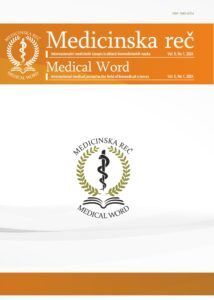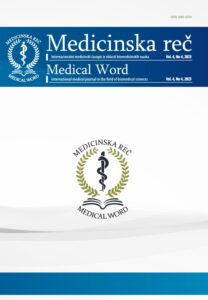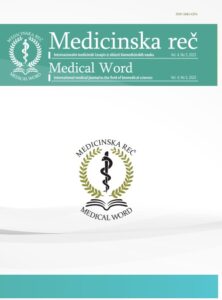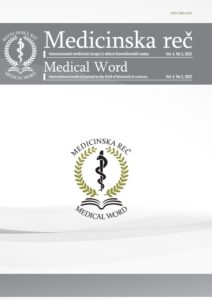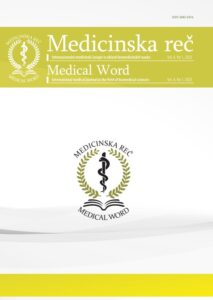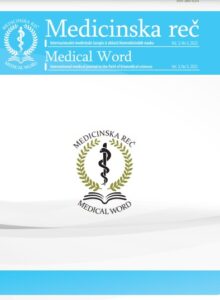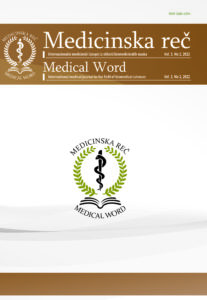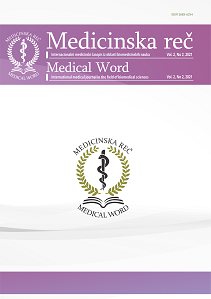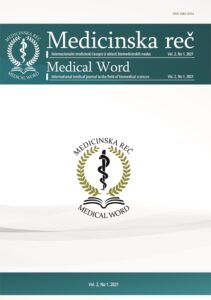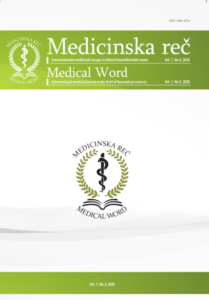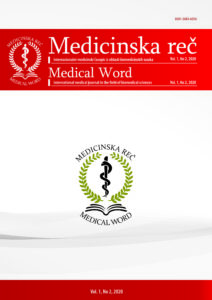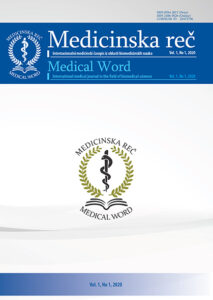Effects of vasoactive therapy in patients with sensorineural hypoacusis
Dejan Rančić, Јоvan Todorović, Marija Mladenović
Med Word 2020; 1(1): 29–35
DOI: https://doi.org/10.5937/medrec2001029R
Abstract
Hearing loss is one of the most common health problems which is manifested by a subjective feeling of impaired hearing, the impossibility of listening in noise, intermittent or constant tinnitus. It can be conductive or sensorineural type (SNHL). Sensorineural hearing loss is caused by degeneration of the cochlea, which is responsible for the transduction of sound stimuli into nerve impulse.
The aim of this study was to determine the effects of the applied vasoactive and hemokinetic therapy in people with sensorineural hypoacusis who refused embedding hearing aids.
This retrospective study included 51 patients, which were in a three-year period in Clinic of Otorhinolaryngology KC Nis diagnosed with sensorineural hearing loss. Patients were clinically evaluated on the basis of the findings of otoscopy and tonal audiometry. Patients were treated with pentoxifylline, vitamins B1 and B6, cinnarizine (older than 50 years) and betahistine (younger than 50 years), for 28 days. After the treatment, using pure tone audiometry, we monitored the frequency of 125-8000 Hz and improvements in decibels. Controls were in 3 to 4 weeks. For analyzing and processing we used the worst finding and the best answer.
Applied therapy led to improvements in all frequencies, particularly at high frequencies (2-8 kHz) (p < .001). Subjective symptoms such as tinnitus were absent, or were losing their intensity. Patients had a subjective feeling of better auditory functionality (better communication, better hearing experience of environment).
In our study, we demonstrated that administration of vasodilators and hemokinetics in the treatment of patients with SNHL has positive effects in all frequencies, especially at high frequencies (2-8 kHz).
Key words: SNHL, vasodilators, hemokinetics, tonal audiometry
References
- LeMasurier M, Gillespie PG. Hair-cell mechanotransduction and cochlear amplification. Neuron 2005; 48: 403–15.
- Hibino H, Kurachi Y. Molecular and physiological bases of the K+ circulation in the mammalian inner ear. Physiology 2006; 21: 336–45.
- Guinan JJ Jr, Salt A, Cheatham MA. Progress in cochlear physiology after Bekesy. Hear Res 2012; 293: 12–20.
- Gates GA, Mills JH. Presbycusis. The Lancet 2005; 366: 1111–20.
- Ryals BM, Dooling RJ, Westbrook E, Dent ML, Mackenzie A, Larsen ON. Avian species differences in susceptibility to noise exposure. Hear Res 1999; 131: 71–88.
- White JA, Burgess BJ, Hall RD, Nadol JB. Pattern of degeneration of the spiral ganglion cell and its processes in the C57BL/6J mouse. Hear Res 2000; 141: 12–18.
- Linthicum FH Jr, Fayad JN. Spiral ganglion cell loss is unrelated to segmental cochlear sensory system degeneration in humans. Otol Neurotol 2009; 30(3): 418–22.
- Ohlemiller KK, Gagnon PM. Apical-to-basal gradients in age-related cochlear degeneration and their relationship to “primary” loss of cochlear neurons. J Comp Neurol 2004; 479: 103–16.
- Schuknecht HF, Gacek MR. Cochlear pathology in presbycusis. Ann. Otol Rhinol Laryngol 1993; 102: 1–16.
- Menardo J, Tang Y, Ladrech S, Lenoir M, Casas F, Michel C, et al. Oxidative stress, inflammation, and autophagic stress as the key mechanisms of premature age-related hearing loss in SAMP8 mouse Cochlea. Antioxid. Redox Signal 2012; 16: 263–74.
- Moser T, Predoehl F, Starr A. Review of hair cell synapse defects in sensorineural hearing impairment. Otol Neurotol 2013; 34: 995–1004.
- Starr A, Picton TW, Sininger Y, Hood LJ, Berlin CI. Auditory neuropathy. Brain 1996; 119(Pt 3): 741–53.
- Kraus N, Bradlow AR, Cheatham MA, Cunningham J, King CD, Koch DB, et al. Consequences of neural asynchrony: a case of auditory neuropathy. J. Assoc Res Otolaryngol 2000; 1: 33–45.
- Plontke S. Therapy of hearing disorders – conservative procedures. GMS Curr Top Otorhinolaryngol Head Neck Surg 2005; 4: Doc 01.
- Bond M, Mealing S, Anderson R, Elston J, Weiner G, Taylor RS, et al. The effectiveness and cost-effectiveness of cochlear implants for severe to profound deafness in children and adults: a systematic review and economic model. Health Techno Assess 2009; 13: 1–330.
- Merchant SN, Nadol JB. Schuknecht’s Pathology of the Ear. Shelton: People’s Medical Publishing House 2010; 942 p.
- Patuzzi R. Ion flow in stria vascularis and the production and regulation of cochlear endolymph and the endolymphatic potential. Hear Res 2011; 277: 4–19.
- Kikuchi T, Adams JC, Miyabe Y, So E, Kobayashi T. Potassium ion recycling pathway via gap junction systems in the mammalian cochlea and its interruption in hereditary nonsyndromic deafness. Med Electron Microsc 2000; 33: 51–6.
- Schütz M, Auth T, Gehrt A, Bosen F, Körber I, Strenzke N, et al. The connexin26 S17F mouse mutant represents a model for the human hereditary keratitis-ichthyosis-deafness syndrome. Hum Mol Genet 2011; 20: 28–39.
- Winkler J, Ramirez GA, Kuhn HG, Peterson DA, Day-Lollini PA, Stewart GR, et al. Reversible Schwann cell hyperplasia and sprouting of sensory and sympathetic neurites after intraventricular administration of nerve growth factor. Ann Neurol 1997; 41: 82–93.
- Williams LR. Hypophagia is induced by intracerebroventricular administration of nerve growth factor. Exp Neurol 1991; 113: 31–7.
- Eriksdotter Jonhagen M, Nordberg A, Amberla K, Backman L, Ebendal T, Meyerson B, et al. Intracerebroventricular infusion of nerve growth factor in three patients with Alzheimer’s disease. Dement. Geriatr Cogn Disord 1998; 9(5): 246–57.
- Lenarz T. Treatment of sudden deafness with the calcium antagonist nimodipine. Results of a comparative study. Laryngorhinootologie 1989; 68(11): 634-7.
- Evans P, Halliwell B. Free radicals and hearing: cause, consequence, and criteria. Ann N Y Acad Sci 1999; 884: 19-40.
- Kopke R, Allen KA, Henderson D, Hoffer M, Frenz D, Van de Water TR. A radical demise: Toxins and trauma share common pathways in hair cell death. Ann N Y Acad Sci 1999; 884: 171- 91.
- Sprem N, Branica S, Dawidowsky K. Vasodilator and vitamins in therapy of sensorineural hearing loss following war-related blast injury: retrospective study. Croat Med J 2001: 42(6): 646–9.
- McCabe BF. Autoimmune inner ear disease: therapy. Am J Otol 1989; 10: 196–7.
- Harris JP. Immunology of the inner ear: response of the inner ear to antigen challenge. Otolaryngol. Head Neck Surg 1983; 91: 18–32.
- Harris JP, Low NC, House WF. Contralateral hearing loss following inner ear injury: sympathetic cochleolabyrinthitis? Am J Otol 1985; 6: 371–7.
- Zhang W, Dai M, Fridberger A, Hassan A, Degagne J, Neng L, et al. Perivascular-resident macrophage-like melanocytes in the inner ear are essential for the integrity of the intrastrial fluid-blood barrier. Proc Natl Acad Sci USA 2012; 109: 10388–93.
- Hirose K, Discolo CM, Keasler JR, Ransohoff R. Mononuclear phagocytes migrate into the murine cochlea after acoustic trauma. J Comp Neurol 2005; 489: 180–94.
- Dai M, Shi X. Fibro-vascular coupling in the control of cochlear blood flow. PLoS ONE 2011; 6(6): e20652.
- Fujioka M, Kanzaki S, Okano HJ, Masuda M, Ogawa K, Okano H. Proinflammatory cytokines expression in noise-induced damaged cochlea. J Neurosci Res 2006; 83: 575–83.
- Fujioka M, Okamoto Y, Shinden S, Okano HJ, Okano H, Ogawa K, et al. Pharmacological inhibition of cochlear mitochondrial respiratory chain induces secondary inflammation in the lateral wall: a potential therapeutic target for sensorineural hearing loss. PLoS ONE 2014; 9(3): e90089.
- Wakabayashi K, Fujioka M, Kanzaki S, Okano HJ, Shibata S, Yamashita D, et al. Blockade of interleukin-6 signaling suppressed cochlear inflammatory response and improved hearing impairment in noise-damaged mice cochlea. Neurosci Res 2010; 66: 345–52.


